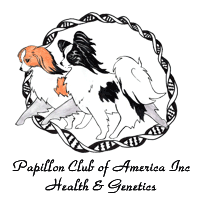
NAD INFORMATION
-
NEUROAXONAL DYSTROPHY DISEASE ( NAD )
INTRODUCTION : Mode of Inheritance is being studied but it has been
determined that it is a progressive disorder where brain and spinal cord
swelling occurs and deterioration continues. Nerve impulses become
abnormal and rear quarter coordination progress to general lack of all
control of movement. The puppy shows signs of pain in later stages.
It is believe to be autosomal recessive. ( This is the same type of inheritance as Progressive Retinal Atrophy PRA ).In order to produce offspring with this disease BOTH parents must carry the gene.
Clinical signs are awkward, clumsy, high stepping puppies Poor coordination, head tremors and in very young puppies it has been observed to be progressive and often by 19 weeks the puppy has to be euthanized on humane grounds. Older puppies continue to deteriorate, have difficulty in swallowing and pneumonia ensues. The brain and spinal cord atrophy ( shrink ).
To read formal abstract descriptions of the disease you may go to :
This information has been obtained through the above literature study .
There are reports of multiple puppy deaths made by some USA breeders.
The above information is furnished to the PCA membership by the Genetic Committee
To read formal research studies that identified the genetic mutation for NAD,
you may go to :
Neuroaxonal Dystrophy Using Whole Exome Sequencing Analysis
While Papillons are generally a healthy breed, there are known genetic problems that affect
some individuals.
The goal of this Committee is to enlighten the breeding community and the general
public about the types of problems that can occur, in the hopes we can all work
together to reduce their incidence.
PCA Health & Genetic Committee

